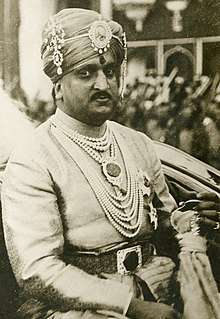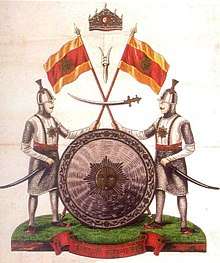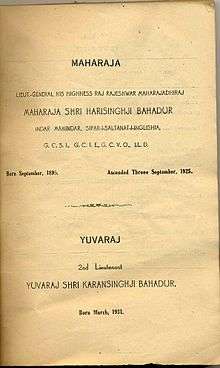Hari Singh
Hari Singh GCSI GCIE GCVO (23 September 1895 – 26 April 1961) was the last ruling Maharaja of the princely state of Jammu and Kashmir in India.
| Hari Singh | |
|---|---|
| Maharaja of Jammu & Kashmir | |
 | |
| Maharaja of Jammu and Kashmir | |
| Reign | 23 September 1925 — June 1949 |
| Predecessor | Pratap Singh |
| Successor | Karan Singh (Prince Regent) |
| Born | 23 September 1895 Jammu, Jammu and Kashmir, British India (present-day Jammu and Kashmir, India) |
| Died | 26 April 1961 (aged 65) Bombay, Maharashtra, India (present-day Mumbai) |
| Spouse | Maharani Tara Devi (4th Wife) |
| Issue | Karan Singh |
| House | Dogra |
| Father | Amar Singh |
| Mother | Rani Bhotiali Chib |
| Religion | Hinduism[1] |
Early life

Hari Singh was born on 23 September 1895 at the palace of Amar Mahal, Jammu, the only surviving son of Raja Amar Singh Jamwal,[2] the brother of Maharaja Pratap Singh, then the Maharaja of Jammu and Kashmir. Since the Maharaja had no issue, Hari Singh was heir to the throne of Jammu and Kashmir.
In 1903, Hari Singh served as a page of honour to Lord Curzon at the grand Delhi Durbar. At the age of thirteen, he was sent to Mayo College in Ajmer. A year later, in 1909, his father died, and the British took a keen interest in his education and appointed Major H. K. Brar as his guardian. After Mayo College, Hari Singh went to the British-run Imperial Cadet Corps at Dehra Dun for military training.
Maharaja Pratap Singh appointed him as the commander-in-chief of the State Forces in 1915.[3]
Personal life
The "youthful escapades" of Hari Singh included paying £300,000 for blackmail by a prostitute in Paris in 1921. That issue had resulted in a court case in London in 1924 during which the India Office tried to keep his name out of proceedings by arranging for him to be referred to as "Mr A."[3]
Singh was known as a lavish spender of money. The funeral of his uncle and former ruler Pratap Singh is believed to have expended much gold and jewellery in the funeral pyre.[4]
Hari Singh's married life is dark. He married four times as his first three wives failed to give birth to his heirs. Each of them died within a few years of childlessness allowing Hari Singh to immediately take a new bride. His last wife, Tara Devi Sahiba of Kangra, had a son.[4]
Reign

Following the death of his uncle Pratap Singh in 1925, Hari Singh ascended the throne of Jammu and Kashmir. He made primary education compulsory in the state, introduced laws prohibiting child marriage, and opened places of worship to the low castes.[5]
The Seal of Maharaja Hari Singh had a Crown at the top. A katar or ceremonial dagger sat below the crown. Two soldiers held flags. An image of the sun was between them, that symbolised his Rajput lineage from Lord Surya, the Hindu Sun God.
1931 Kashmir agitation & Kashmir Martyrs' Day. Hari Singh was believed to have been hostile towards the Indian National Congress, in part because of the close friendship between Kashmiri political activist and socialist Sheikh Abdullah and the Congress leader Jawaharlal Nehru. He also opposed the Muslim League and its members' communalist outlook, as represented by their two-nation theory.
Partition and accession

In 1947, after India gained independence from British rule, Jammu and Kashmir could have joined India, joined Pakistan, or remained independent. Hari Singh originally manoeuvred to maintain his independence by playing off India and Pakistan. There was a widespread belief that rulers of the princely states, in deciding to accede to India or Pakistan, should respect the wishes of the population, but few rulers took any steps to consult on such decisions. Jammu and Kashmir was a Muslim majority state. Pashtun Tribesman from Pakistan then invaded Kashmir and defeated Hari Singh's forces. Hari Singh appealed to India for help.[6] Although the Indian Prime Minister Nehru was ready to send troops, the Governor-General of India, Lord Mountbatten of Burma, advised the Maharaja to accede to India before India could send its troops. Hence, considering the emergency situation, the Maharaja signed the Instrument of Accession on 26 October 1947, joining the whole of his princely state (including Jammu, Kashmir, Northern Areas, Ladakh, Trans-Karakoram Tract and Aksai Chin) to the Dominion of India.[7][8][9] These events triggered the first Indo-Pakistan War.
Pressure from Nehru and Sardar Patel eventually compelled Hari Singh to appoint his son and heir, Yuvraj (crown prince) Karan Singh, as Regent of Jammu and Kashmir in 1949, although he remained titular Maharaja of the state until 1952, when the monarchy was abolished. He was also forced to appoint the popular Kashmiri leader Sheikh Abdullah as the prime minister of Kashmir. He had a contentious relationship with both Nehru and Abdullah.[10] Karan Singh was appointed 'Sadr-e-Riyasat' ('Head of State') in 1952 and Governor of the State in 1964.[10] Abdullah would later be dismissed from his position as prime minister of Kashmir and jailed by Karan Singh.[11]
Nehru and Abdullah conspired to banish the Maharaja from Jammu and Kashmir and forced him to live in exile in Bombay for fourteen years till his death there,Hari Singh spent his final days in Bombay. He died on 26 April 1961. As per his will, his ashes were brought to Jammu and spread all over Jammu and Kashmir and immersed in the Tawi River at Jammu.[12]
Family
He was married four times. With his fourth wife, Maharani Tara Devi (1910–1967), he had one son, Yuvraj (crown prince) Karan Singh.[13]
- Spouses:
- Dharampur Rani Sri Lal Kunverba Sahiba; married at Rajkot 7 May 1913, died during pregnancy in 1915. No children.
- Rani Sahiba; married at Chamba 8 November 1915, died 31 January 1920. No children.
- Maharani Dhanvant Kunveri Baiji Sahiba (1910–19?); married at Dharampur 30 April 1923. No children.
- Maharani Tara Devi Sahiba of Kangra,(1910–1967); married 1928, separated 1950, one child:
- Yuvraj (crown prince, i.e. heir apparent) Karan Singh (born 9 March 1931)
Honours

(ribbon bar, as it would look today; incomplete)
![]()
![]()
![]()
![]()
![]()
![]()
![]()
![]()
![]()
![]()
![]()
![]()
![]()
![]()
- Delhi Durbar Medal-1903
- Delhi Durbar Medal-1911
- Prince of Wales Visit Medal-1922
- Knight Grand Commander of the Order of the Indian Empire (GCIE)-1929 (KCIE-1918)
- Grand Cross of the Order of the Crown of Italy-1930
- Knight Grand Commander of the Order of the Star of India (GCSI)-1933
- King George V Silver Jubilee Medal-1935
- King George VI Coronation Medal-1937
- Hon. LL.D from Punjab University-1938
- Grand Officer of the Legion d'Honneur-1938
- 1939-1945 Star-1945
- Africa Star-1945
- War Medal 1939-1945-1945
- India Service Medal-1945
- Knight Grand Cross of the Royal Victorian Order (GCVO)-1946 (KCVO-1922)
- Indian Independence Medal-1947
Hari Singh Born: 23 September 1895 Died: 26 April 1961 | ||
| Regnal titles | ||
|---|---|---|
| Preceded by Pratap Singh (as Maharaja of Jammu and Kashmir) |
Maharaja of Jammu and Kashmir 1925–1952 |
Succeeded by Abolished |
References
- Mridu Rai, Hindu Rulers, Muslim Subjects 2004.
- General Sir Raja Amar Singh Jamwal: 14 January 1865 – 26 March 1909
- Snedden, Christopher (2015). Understanding Kashmir and Kashmiris. Oxford University Press. p. 128. ISBN 978-1-84904-342-7.
- Kashmir’s Last Maharaja, Kashmir Life, 2 May 2011.
- Anand, Ragubhir Lal (1 February 2014). IS God DEAD?????. Partridge Publishing. p. 26. ISBN 978-1-48281-823-9.
- "Maharaja Hari Singh's Letter to Mountbatten". www.jammu-kashmir.com. Retrieved 10 January 2020.
- Ramachandra., Guha (1 January 2008). India after Gandhi : the history of the world's largest democracy. Harper Perennial. ISBN 978-0060958589. OCLC 474262656.
- Justice A. S. Anand, The Constitution of Jammu & Kashmir (5th edition, 2006), page 67
- Kashmir, Research Paper 04/28 by Paul Bowers, House of Commons Library, United Kingdom. Archived 28 July 2004 at the Wayback Machine, page 46, 30 March 2004
- Ramachandra., Guha (1 January 2008). India after Gandhi : the history of the world's largest democracy. Harper Perennial. p. 92. ISBN 978-0060958589. OCLC 474262656.
- Ramachandra., Guha (1 January 2008). India after Gandhi : the history of the world's largest democracy. Harper Perennial. p. 262. ISBN 978-0060958589. OCLC 474262656.
- Dynasty clash in Kashmir: Hari Singh's grandson Ajatshatru challenges Abdullahs, The Economic Times, 14 March 2013.
- Mufti, Kashmir in Sickness and in Health 2013, p. 157.
Bibliography
- Rai, Mridu (2004), Hindu Rulers, Muslim Subjects: Islam, Rights, and the History of Kashmir, C. Hurst & Co, ISBN 1850656614
- Mufti, Gulzar (2013), Kashmir in Sickness and in Health, Partridge Publishing India, ISBN 978-1-4828-0998-5
External links
| Wikimedia Commons has media related to Hari Singh. |
- Proclamation of 1 May 1951 on Jammu & Kashmir Constituent Assembly by Yuvraj (Crown Prince) Karan Singh (Son of Maharajah Hari Singh) from the Official website of Government of Jammu and Kashmir, India
- Conflict in Kashmir: Selected Internet Resources by the Library, University of California, Berkeley, USA; University of California at Berkeley Library Bibliographies and Web-Bibliographies list
- V Sundaram. "Salutations to Guruji Golwalkar – IV". Archived from the original on 4 December 2008. The role of Shri Guruji Golwalkar (Sarsanghchalak of the Rashtriya Swayamsevak Sangh – RSS)
- Nehru, Abdullah betrayed Maharaja Hari Singh
- Banished from his own land